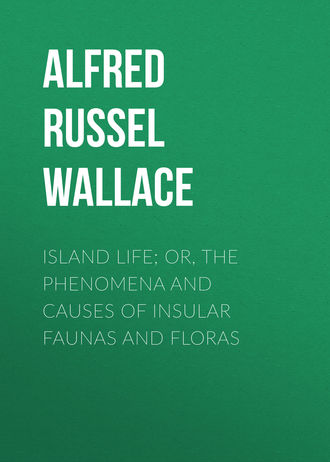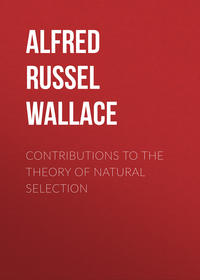 полная версия
полная версияIsland Life; Or, The Phenomena and Causes of Insular Faunas and Floras
The facts here seem a little inconsistent, and we must suppose that Dr. Croll has somewhat exaggerated the universality and complete preservation of the glaciated surface. The amount of average denudation, however, is not a matter of opinion but of measurement; and its consequences can in no way be evaded. They are, moreover, strictly proportionate to the time elapsed; and if so much of the old surface of the country has certainly been remodelled or carried into the sea since the last glacial epoch, it becomes evident that any surface-phenomena produced by still earlier glacial epochs must have long since entirely disappeared.
Rise of the Sea-level Connected with Glacial Epochs, a Cause of Further Denudation.—There is also another powerful agent that must have assisted in the destruction of any such surface deposits or markings. During the last glacial epoch itself there were several minor oscillations of the land, without counting the great submergence of over 1,300 feet, supposed to be indicated by patches of shelly clays and gravels in Wales and Ireland, and also in a few localities in England and Scotland, since these are otherwise explained by many geologists. Other subsidences have no doubt occurred in the same areas during the Tertiary epoch, and some writers connect these subsidences with the glacial period itself, the unequal amount of ice at the two poles causing the centre of gravity of the earth to be displaced when, of course, the surface of the ocean will conform to it and appear to rise in the one hemisphere and sink in the other. If this is the case, subsidences of the land are natural concomitants of a glacial period, and will powerfully aid in removing all evidence of its occurrence. We have seen reason to believe, however, that during the height of the glacial epoch the extreme cold persisted through the successive phases of precession, and if so, both polar areas would probably be glaciated at once. This would cause the abstraction of a large quantity of water from the ocean, and a proportionate elevation of the land, which would react on the accumulation of snow and ice, and thus add another to that wonderful series of physical agents which act and react on each other so as to intensify glacial epochs.
But whether or not these causes would produce any important fluctuations of the sea-level is of comparatively little importance to our present inquiry, because the wide extent of marine Tertiary deposits in the northern hemisphere and their occurrence at considerable elevations above the present sea-level, afford the most conclusive proofs that great changes of sea and land have occurred throughout the entire Tertiary period; and these repeated submergences and emergences of the land combined with sub-aërial and marine denudation, would undoubtedly destroy all those superficial evidences of ice-action on which we mainly depend for proofs of the occurrence of the last glacial epoch.
What Evidence of Early Glacial Epochs may be Expected.—Although we may admit the force of the preceding argument as to the extreme improbability of our finding any clear evidence of the superficial action of ice during remote glacial epochs, there is nevertheless one kind of evidence that we ought to find, because it is both wide-spread and practically indestructible.
One of the most constant of all the phenomena of a glaciated country is the abundance of icebergs produced by the breaking off of the ends of glaciers which terminate in arms of the sea, or of the terminal face of the ice-sheet which passes beyond the land into the ocean. In both these cases abundance of rocks and débris, such as form the terminal moraines of glaciers on land, are carried out to sea and deposited over the sea-bottom of the area occupied by icebergs. In the case of an ice-sheet it is almost certain that much of the ground-moraine, consisting of mud and imbedded stones, similar to that which forms the "till" when deposited on land, will be carried out to sea with the ice and form a deposit of marine "till" near the shore.
It has indeed been objected that when an ice-sheet covered an entire country there would be no moraines, and that rocks or débris are very rarely seen on icebergs. But during every glacial epoch there will be a southern limit to the glaciated area, and everywhere near this limit the mountain-tops will rise far above the ice and deposit on it great masses of débris; and as the ice-sheet spreads, and again as it passes away, this moraine-forming area will successively occupy the whole country. But even such an ice-clad country as Greenland is now known to have protruding peaks and rocky masses which give rise to moraines on its surface;64 and, as rocks from Cumberland and Ireland were carried by the ice-sheet to the Isle of Man, there must have been a very long period during which the ice-sheets of Britain and Ireland terminated in the ocean and sent off abundance of rock-laden bergs into the surrounding seas; and the same thing must have occurred along all the coasts of Northern Europe and Eastern America.
We cannot therefore doubt that throughout the greater part of the duration of a glacial epoch the seas adjacent to the glaciated countries would receive continual deposits of large rocks, rock-fragments, and gravel, similar to the material of modern and ancient moraines, and analogous to the drift and the numerous travelled blocks which the ice has undoubtedly scattered broadcast over every glaciated country; and these rocks and boulders would be imbedded in whatever deposits were then forming, either from the matter carried down by rivers or from the mud ground off the rocks and carried out to sea by the glaciers themselves. Moreover, as icebergs float far beyond the limits of the countries which gave them birth, these ice-borne materials would be largely imbedded in deposits forming from the denudation of countries which had never been glaciated, or from which the ice had already disappeared.
But if every period of high excentricity produced a glacial epoch of greater or less extent and severity, then, on account of the frequent occurrence of a high phase of excentricity during the three million years for which we have the tables, these boulder and rock-strewn deposits would be both numerous and extensive. Four hundred thousand years ago the excentricity was almost exactly the same as it is now, and it continually increased from that time up to the glacial epoch. Now if we take double the present excentricity as being sufficient to produce some glaciation in the temperate zone, we find (by drawing out the diagram at p. 171 on a larger scale) that during 1,150,000 years out of the 2,400,000 years immediately preceding the last glacial epoch, the excentricity reached or exceeded this amount, consisting of sixteen separate epochs, divided from each other by periods varying from 30,000 to 200,000 years. But if the last glacial epoch was at its maximum 200,000 years ago, a space of three million years will certainly include much, if not all, of the Tertiary period; and even if it does not, we have no reason to suppose that the character of the excentricity would suddenly change beyond the three million years.
It follows, therefore, that if periods of high excentricity, like that which appears to have been synchronous with our last glacial epoch and is generally admitted to have been one of its efficient causes, always produced glacial epochs (with or without alternating warm periods), then the whole of the Tertiary deposits in the north temperate and Arctic zones should exhibit frequent alternations of boulder and rock-bearing beds, or coarse rock-strewn gravels analogous to our existing glacial drift, and with some corresponding change of organic remains. Let us then see what evidence can be adduced of the existence of such deposits, and whether it is adequate to support the theory of repeated glacial epochs during the Tertiary period.
Evidences of Ice-action during the Tertiary Period.—The Tertiary fossils both of Europe and North America indicate throughout warm or temperate climates, except those of the more recent Pliocene deposits which merge into the earlier glacial beds. The Miocene deposits of Central and Southern Europe, for example, contain marine shells of some genera now only found farther south, while the fossil plants often resemble those of Madeira and the southern states of North America. Large reptiles, too, abounded, and man-like apes lived in the south of France and in Germany. Yet in Northern Italy, near Turin, there are beds of sandstone and conglomerate full of characteristic Miocene shells, but containing in an intercalated deposit angular blocks of serpentine and greenstone often of enormous size, one being fourteen feet long, and another twenty-six feet. Some of the blocks were observed by Sir Charles Lyell to be faintly striated and partly polished on one side, and they are scattered through the beds for a thickness of nearly 150 feet. It is interesting that the particular bed in which the blocks occur yields no organic remains, though these are plentiful both in the underlying and overlying beds, as if the cold of the icebergs, combined with the turbidity produced by the glacial mud, had driven away the organisms adapted to live only in a comparatively warm sea. Rock similar in kind to these erratics occurs about twenty miles distant in the Alps.
The Eocene period is even more characteristically tropical in its flora and fauna, since palms and Cycadaceæ, turtles, snakes, and crocodiles then inhabited England. Yet on the north side of the Alps, extending from Switzerland to Vienna, and also south of the Alps near Genoa, there is a deposit of finely-stratified sandstone several thousand feet in thickness, quite destitute of organic remains, but containing in several places in Switzerland enormous blocks either angular or partly rounded, and composed of oolitic limestone or of granite. Near the Lake of Thun some of the granite blocks found in this deposit are of enormous size, one of them being 105 feet long, ninety feet wide, and forty-five feet thick! The granite is red, and of a peculiar kind which cannot be matched anywhere in the Alps, or indeed elsewhere. Similar erratics have also been found in beds of the same age in the Carpathians and in the Apennines, indicating probably an extensive inland European sea into which glaciers descended from the surrounding mountains, depositing these erratics, and cooling the water so as to destroy the mollusca and other organisms which had previously inhabited it. It is to be observed that wherever these erratics occur they are always in the vicinity of great mountain ranges; and although these can be proved to have been in great part elevated during the Tertiary period, we must also remember that they must have been since very much lowered by denudation, of the amount of which, the enormously thick Eocene and Miocene beds now forming portions of them is in some degree a measure as well as a proof. It is not therefore at all improbable that during some part of the Tertiary period these mountains may have been far higher than they are now, and this we know might be sufficient for the production of glaciers descending to the sea-level, even were the climate of the lowlands somewhat warmer than at present.65
The Weight of the Negative Evidence.—But when we proceed to examine the Tertiary deposits of other parts of Europe, and especially of our own country, for evidence of this kind, not only is such evidence completely wanting, but the facts are of so definite a character as to satisfy most geologists that it can never have existed; and the same maybe said of temperate North America and of the Arctic regions generally.
In his carefully written paper on "The Climate Controversy" the late Mr. Searles V. Wood, Jun., remarks on this point as follows: "Now the Eocene formation is complete in England, and is exposed in continuous section along the north coast of the Isle of Wight from its base to its junction with the Oligocene (or Lower Miocene according to some), and along the northern coast of Kent from its base to the Lower Bagshot Sand. It has been intersected by railway and other cuttings in all directions and at all horizons, and pierced by wells innumerable; while from its strata in England, France, and Belgium, the most extensive collections of organic remains have been made of any formation yet explored, and from nearly all its horizons, for at one place or another in these three countries nearly every horizon may be said to have yielded fossils of some kind. These fossils, however, whether they be the remains of a flora such as that of Sheppey, or of a vertebrate fauna containing the crocodile and alligator, such as is yielded by beds indicative of terrestrial conditions, or of a molluscan assemblage such as is present in marine or fluvio-marine beds of the formation, are of unmistakably tropical or sub-tropical character throughout; and no trace whatever has appeared of the intercalation of a glacial period, much less of successive intercalations indicative of more than one period of 10,500 years' glaciation. Nor can it be urged that the glacial epochs of the Eocene in England were intervals of dry land, and so have left no evidence of their existence behind them, because a large part of the continuous sequence of Eocene deposits in this country consists of alternations of fluviatile, fluvio-marine, and purely marine strata; so that it seems impossible that during the accumulation of the Eocene formation in England a glacial period could have occurred without its evidences being abundantly apparent. The Oligocene of Northern Germany and Belgium, and the Miocene of those countries and of France, have also afforded a rich molluscan fauna, which, like that of the Eocene, has as yet presented no indication of the intrusion of anything to interfere with its uniformly sub-tropical character."66
This is sufficiently striking; but when we consider that this enormous series of deposits, many thousand feet in thickness, consists wholly of alternations of clays, sands, marls, shales, or limestones, with a few beds of pebbles or conglomerate, not one of the whole series containing irregular blocks of foreign material, boulders or gravel, such as we have seen to be the essential characteristic of a glacial epoch; and when we find that this same general character pervades all the extensive Tertiary deposits of temperate North America, we shall, I think, be forced to the conclusion that no general glacial epochs could have occurred during their formation. It must be remembered that the "imperfection of the geological record" will not help us here, because the series of Tertiary deposits is unusually complete, and we must suppose some destructive agency to have selected all the intercalated glacial beds and to have so completely made away with them that not a fragment remains, while preserving all or almost all the interglacial beds; and to have acted thus capriciously, not in one limited area only, but over the whole northern hemisphere, with the local exceptions on the flanks of great mountain ranges already referred to.
Temperate Climates in the Arctic Regions.—As we have just seen, the geological evidence of the persistence of sub-tropical or warm climates in the north temperate zone during the greater part of the Tertiary period is almost irresistible, and we have now to consider the still more extraordinary series of observations which demonstrate that this amelioration of climate extended into the Arctic zone, and into countries now almost wholly buried in snow and ice. These warm Arctic climates have been explained by Dr. Croll as due to periods of high excentricity with winter in perihelion, a theory which implies alternating epochs of glaciation far exceeding what now prevails; and it is therefore necessary to examine the evidence pretty closely in order to see if this view is more tenable in the case of the north polar regions than we have found it to be in that of the north temperate zone.
The most recent of these milder climates is perhaps indicated by the abundant remains of large mammalia—such as the mammoth, woolly rhinoceros, bison and horse, in the icy alluvial plains of Northern Siberia, and especially in the Liakhov Islands in the same latitude as the North Cape of Asia. These remains occur not in one or two spots only, as if collected by eddies at the mouth of a river, but along the whole borders of the Arctic Ocean; and it is generally admitted that the animals must have lived upon the adjacent plains, and that a considerably milder climate than now prevails could alone have enabled them to do so. How long ago this occurred we do not know, but one of the last intercalated mild periods of the glacial epoch itself seems to offer all the necessary conditions. Again, Sir Edward Belcher discovered on the dreary shores of Wellington Channel in 75½° N. Lat. the trunk and root of a fir tree which had evidently grown where it was found. It appeared to belong to the species Abies alba, or white fir, which now reaches 68° N. Lat. and is the most northerly conifer known. Similar trees, one four feet in circumference and thirty feet long, were found by Lieut. Mecham in Prince Patrick's Island in Lat. 76° 12′ N., and other Arctic explorers have found remains of trees in high latitudes.67
Similar indications of a recent milder climate are found in Spitzbergen. Professor Nordenskjöld says: "At various places on Spitzbergen, at the bottom of Lomme Bay, at Cape Thordsen, in Blomstrand's strata in Advent Bay, there are found large and well-developed shells of a bivalve, Mytilus edulis, which is not now found living on the coast of Spitzbergen, though on the west coast of Scandinavia it everywhere covers the rocks near the sea-shore. These shells occur most plentifully in the bed of a river which runs through Reindeer Valley at Cape Thordsen. They are probably washed out of a thin bed of sand at a height of about twenty or thirty feet above the present sea-level, which is intersected by the river. The geological age of this bed cannot be very great, and it has clearly been formed since the present basin of the Ice Sound, or at least the greater part of it, has been hollowed out by glacial action."68
The Miocene Arctic Flora.—One of the most startling and important of the scientific discoveries of the last forty years has been that of the relics of a luxuriant Miocene flora in various parts of the Arctic regions. It is a discovery that was totally unexpected, and is even now considered by many men of science to be completely unintelligible; but it is so thoroughly established, and it has such a direct and important bearing on the subjects we are discussing in the present volume, that it is necessary to lay a tolerably complete outline of the facts before our readers.
The Miocene flora of temperate Europe was very like that of Eastern Asia, Japan, and the warmer part of Eastern North America of the present day. It is very richly represented in Switzerland by well preserved fossil remains, and after a close comparison with the flora of other countries Professor Heer concludes that the Swiss Lower Miocene flora indicates a climate corresponding to that of Louisiana, North Africa, and South China, while the Upper Miocene climate of the same country would correspond to that of the south of Spain, Southern Japan, and Georgia (U.S. of America). Of this latter flora, found chiefly at Œninghen in the northern extremity of Switzerland, 465 species are known, of which 166 species are trees or shrubs, half of them being evergreens. They comprise sequoias like the Californian giant trees, camphor-trees, cinnamons, sassafras, bignonias, cassias, gleditschias, tulip-trees, and many other American genera, together with maples, ashes, planes, oaks, poplars, and other familiar European trees represented by a variety of extinct species. If we now go to the west coast of Greenland in 70° N. Lat. we find abundant remains of a flora of the same general type as that of Œninghen but of a more northern character. We have a sequoia identical with one of the species found at Œninghen, a chestnut, salisburia, liquidambar, sassafras, and even a magnolia. We have also seven species of oaks, two planes, two vines, three beeches, four poplars, two willows, a walnut, a plum, and several shrubs supposed to be evergreens; altogether 137 species, mostly well and abundantly preserved!
But even further north, in Spitzbergen, in 78° and 79° N. Lat. and one of the most barren and inhospitable regions on the globe, an almost equally rich fossil flora has been discovered including several of the Greenland species, and others peculiar, but mostly of the same genera. There seem to be no evergreens here except coniferæ, one of which is identical with the swamp-cypress (Taxodium distichum) now found living in the Southern United States! There are also eleven pines, two Libocedrus, two sequoias, with oaks, poplars, birches, planes, limes, a hazel, an ash, and a walnut; also water-lilies, pond-weeds, and an iris—altogether about a hundred species of flowering plants. Even in Grinnell Land, within 8¼ degrees of the pole, a similar flora existed, twenty-five species of fossil plants having been collected by the last Arctic expedition, of which eighteen were identical with the species from other Arctic localities. This flora comprised poplars, birches, hazels, elms, viburnums, and eight species of conifers including the swamp cypress and the Norway spruce (Pinus abies) which last does not now extend beyond 69½° N.
Fossil plants closely resembling those just mentioned have been found at many other Arctic localities, especially in Iceland, on the Mackenzie River in 65° N. Lat. and in Alaska. As an intermediate station we have, in the neighbourhood of Dantzic in Lat. 55° N., a similar flora, with the swamp-cypress, sequoias, oaks, poplars, and some cinnamons, laurels, and figs. A little further south, near Breslau, north of the Carpathians, a rich flora has been found allied to that of Œninghen, but wanting in some of the more tropical forms. Again, in the Isle of Mull in Scotland, in about 56½° N. Lat., a plant-bed has been discovered containing a hazel, a plane, and a sequoia, apparently identical with a Swiss Miocene species.
We thus find one well-marked type of vegetation spread from Switzerland and Vienna to North Germany, Scotland, Iceland, Greenland, Alaska, and Spitzbergen, some few of the species even ranging over the extremes of latitude between Œninghen and Spitzbergen, but the great majority being distinct, and exhibiting decided indications of a decrease of temperature according to latitude, though much less in amount than now exists. Some writers have thought that the great similarity of the floras of Greenland and Œninghen is a proof that they were not contemporaneous, but successive; and that of Greenland has been supposed to be as old as the Eocene. But the arguments yet adduced do not seem to prove such a difference of age, because there is only that amount of specific and generic diversity between the two which might be produced by distance and difference of temperature, under the exceptionally equable climate of the period. We have even now examples of an equally wide range of well-marked types; as in temperate South America, where many of the genera and some of the species range from the Straits of Magellan to Valparaiso—places differing as much in latitude as Switzerland and West Greenland; and the same may be said of North Australia and Tasmania, where, at a greater latitudinal distance apart, closely allied forms of Eucalyptus, Acacia, Casuarina, Stylidium, Goodenia, and many other genera would certainly form a prominent feature in any fossil flora now being preserved.
Mild Arctic Climates of the Cretaceous Period.—In the Upper Cretaceous deposits of Greenland (in a locality not far from those of the Miocene age last described) another remarkable flora has been discovered, agreeing generally with that of Europe and North America of the same geological age. Sixty-five species of plants have been identified, of which there are fifteen ferns, two cycads, eleven coniferæ, three monocotyledons, and thirty-four dicotyledons. One of the ferns is a tree-fern with thick stems, which has also been found in the Upper Greensand of England. Among the conifers the giant sequoias are found, and among the dicotyledons the genera Populus, Myrica, Ficus, Sassafras, Andromeda, Diospyros, Myrsine, Panax, as well as magnolias, myrtles, and leguminosæ. Several of these groups occur also in the much richer deposits of the same age in North America and Central Europe; but all of them evidently afford such fragmentary records of the actual flora of the period, that it is impossible to say that any genus found in one locality was absent from the other merely because it has not yet been found there. On the whole, there seems to be less difference between the floras of Arctic and temperate latitudes in Upper Cretaceous than in Miocene times.









